
Arrhenius is a lunar impact crater that is located just on the far side of the Moon, near the southwest limb. In this location the vicinity of the crater can be viewed during favorable librations, although it is viewed from on edge. To the south-southeast is the worn crater Blanchard, and De Roy lies further to the west.

Boss is a lunar impact crater that is located along the northeast rim of the Moon's near side. Due to its location, the crater is viewed from the side by observers on the Earth, and its visibility is subject to libration effects. It was named by the IAU in 1964 for astronomer Lewis Boss.

Beals is a lunar impact crater that is located near the eastern limb of the Moon, and lies across the southwestern rim of the crater Riemann. From the Earth the crater is viewed nearly from on edge, and is best seen during favorable librations. To the west is the large walled plain Gauss.

Baldet is a lunar impact crater that is located on the southern hemisphere on the far side of the Moon. It lies in the lava-flooded region between the craters Cori to the north, Stoney to the southwest, and the worn walled plain Minkowski to the southeast.

Cusanus is a lunar impact crater that is located near the northeastern limb of the Moon. In this location the crater appears very foreshortened when observed from the Earth, and its visibility is affected by libration. The northern rim of Cusanus is nearly joined to the south-southeastern rim of the larger crater Petermann. To the west is Baillaud and to the southeast is Hayn.

Mercurius is a lunar impact crater that is located in the northeastern part of the Moon. It was named by the IAU in 1935.
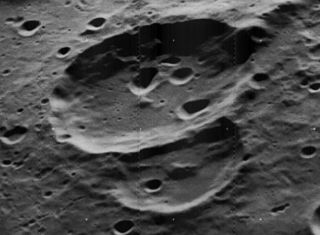
Chaffee is a lunar impact crater that is located in the southern hemisphere on the far side of the Moon. It lies within the huge walled plain Apollo, and is one of several craters in that formation named for astronauts and people associated with the Apollo program. This basin is a double-ringed formation, and the crater Chaffee is situated across the southwest part of the inner ring. The ridge from this ring extends northward from the northern rim of Chaffee.

Davisson is a lunar impact crater that is located on the far side of the Moon from the Earth. This crater lies across the eastern rim of the huge walled plain Leibnitz, and the rim and outer rampart intrudes into the interior floor of Leibnitz. To the east-northeast of Davisson is the walled plain Oppenheimer, a formation only somewhat smaller than Leibnitz.

Carnot is a large crater in the northern part of the Moon's far side. It was named after Nicolas L. S. Carnot by the IAU in 1970.

Dyson is a lunar impact crater, 63 kilometers in diameter, that lies on the far side of the Moon, past the northwest limb. It is located in the northern part of the surface, to the northwest of the crater Coulomb, and east of van't Hoff.
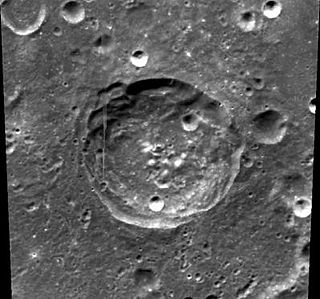
Stoney is an impact crater on the Moon, located in the southern part of its far side, approximately 47.5 kilometers in diameter. In 1970, it was named by IAU's Working Group for Planetary System Nomenclature after Anglo-Irish physicist George Johnstone Stoney (1826–1911). It lies to the southeast of the crater Baldet and to the east of Bhabha.
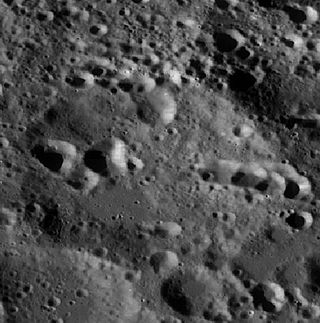
Chandler is a lunar impact crater in the northern hemisphere, on the Moon's far side. It lies to the southeast of the large walled plain D'Alembert, and southeast of the slightly smaller Chernyshev crater.

Chaplygin is a large lunar impact crater that lies on the far side of the Moon. It is located to the southeast of the huge walled plain Mendeleev, about midway between the craters Schliemann to the northeast and Marconi to the southwest. It is about the same size as Albategnius on the near side.

Chauvenet is a lunar impact crater that is located to the northeast of the prominent crater Tsiolkovskiy on the far side of the Moon. Less than one crater diameter to the northwest of Chauvenet is the crater Ten Bruggencate.

Pilâtre is a lunar impact crater near the southwestern limb of the Moon. It is located just to the north-northwest of the much larger walled plain Hausen. The satellite crater Pingré S is attached to the eastern rim, with Pingré itself located farther to the northeast. Just to the west-southwest is Chappe, a formation of similar dimension to Pilâtre.
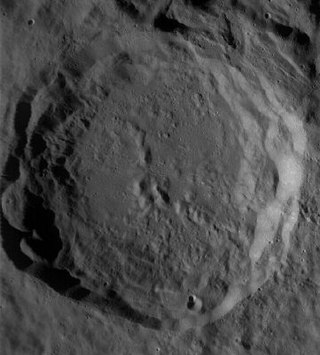
Von Neumann is a lunar impact crater that lies on the far side of the Moon, in the northern hemisphere, named after polymath John von Neumann. It is nearly attached to the south-southeastern rim of the walled plain Campbell. The crater Ley is attached to the northeastern rim of Von Neumann, and is somewhat overlain by the outer rampart. To the west is the prominent Wiener, and to the south-southwest is Nikolayev.

Delporte is a lunar impact crater on the far side of the Moon. It overlies part of the northwestern rim of the huge walled plain Fermi, and the crater Litke is nearly attached to the southeastern rim.

Dobrovolʹskiy is a small lunar impact crater on the Moon's far side. The northwest part of its rim is intruded upon by the somewhat larger crater Shirakatsi, and the outer rampart of that feature covers most of the interior floor of Dobrovolʹskiy. Very little of the original floor now survives, with a small section near the southern inner wall. The remainder of the crater rim is somewhat circular and only mildly worn.

Ehrlich is a small lunar impact crater named after the German scientist Paul Ehrlich. It is located in the northern hemisphere on the Moon's far side. It lies within a rugged region that has been extensively bombarded by impacts of comparable size. Ehrlich lies about midway between the craters Parsons to the south and the heavily worn Guillaume to the north.
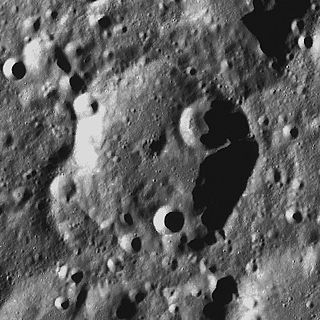
Perkin is a lunar impact crater that is located in the northern hemisphere on the Moon's far side. Immediately to the north is the larger crater Debye. Just to the southeast is the somewhat smaller cater Guillaume, and to the west-southwest lies Dunér. To the northwest of Perkin is the large walled plain D'Alembert.






















